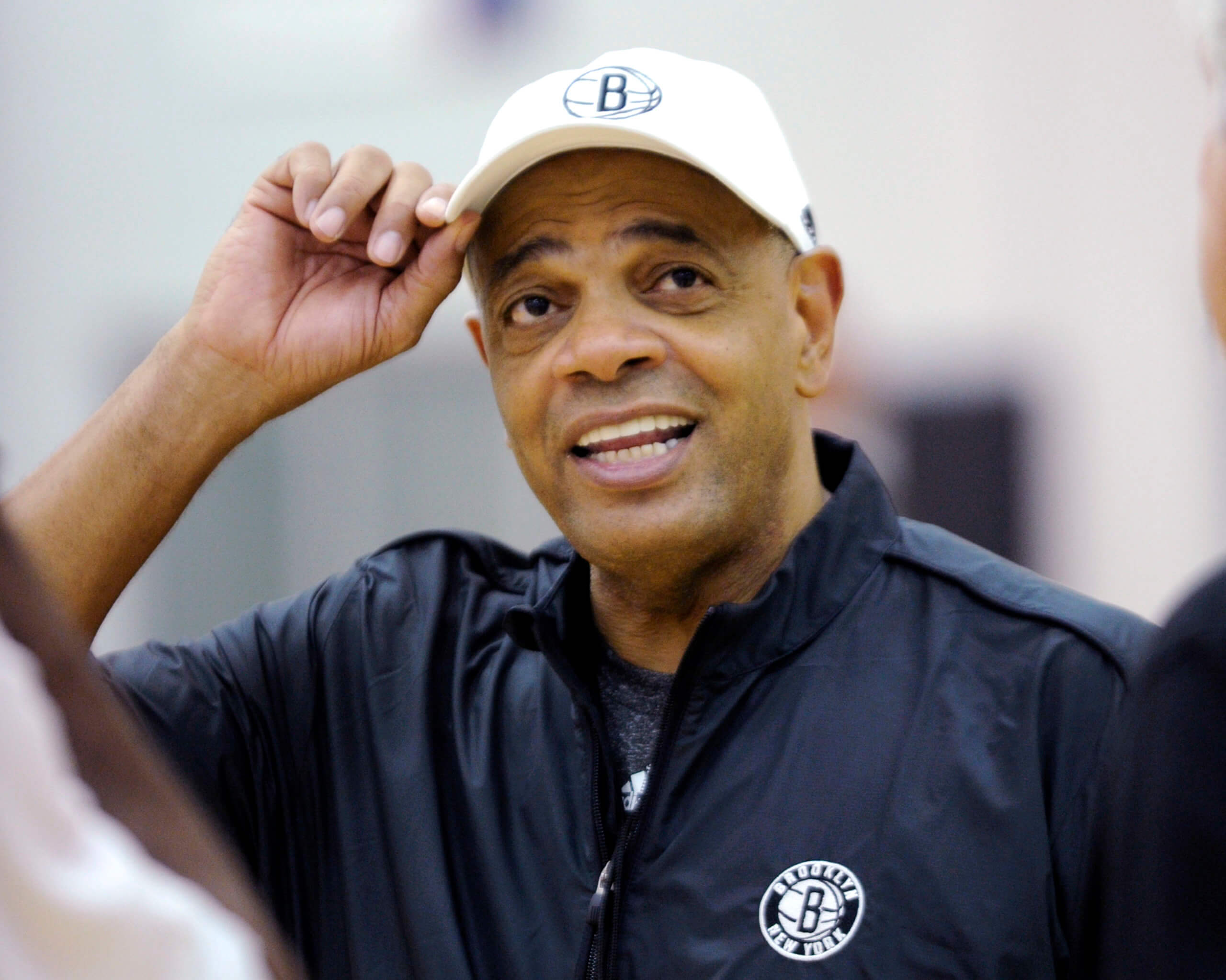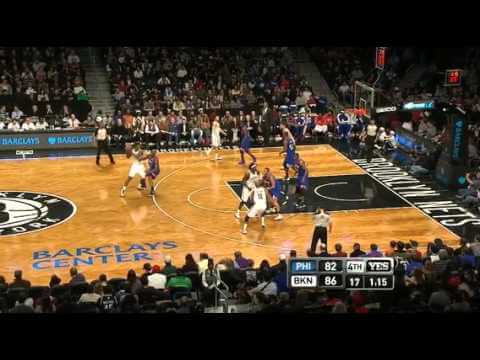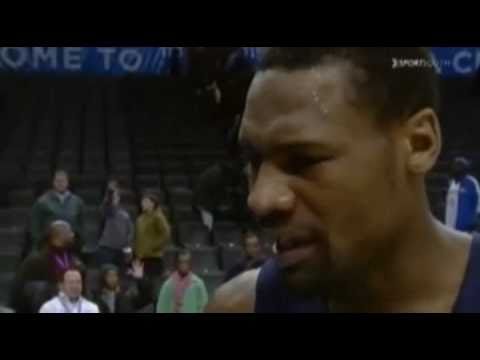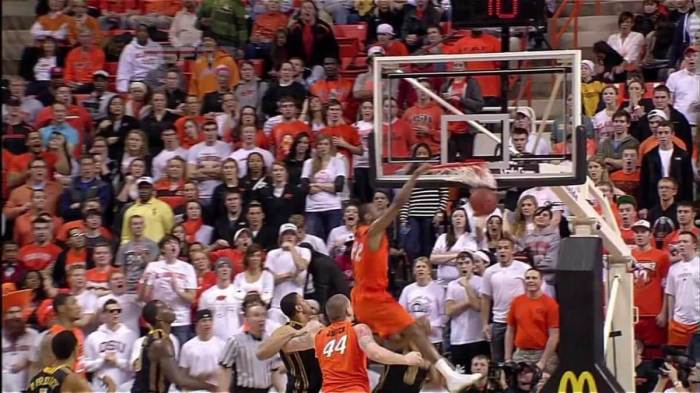
During a five-on-five drill at Nets practice, Deron Williams shot down the left side of the court, curling to the opposite block to set a screen for Nets guard Bojan Bogdanovic. After setting the screen, Williams curled upwards, brushed Brook Lopez’s shoulder, caught a pass from guard Joe Johnson on the right wing, and buried a three-pointer nothing but net.
On the next play, Lopez posted up his defender about above the left elbow, about 19 feet from the basket. “Get down, Brook!” Williams yelled.
After the play — which ended with an open Lopez jumper, created by a double-team Williams drew inside — Williams instructed his teammate. “You can’t do that,” Williams said, before pointing him closer to the high post and giving him further advice on positioning.
There’s a reason Williams already looks more comfortable than in years past. For one, he’s healthy, after offseason surgery to remove bone spurs from his left ankle and loose a bone fragment in his right ankle. But just as important, he’s been here before.
“The system that we’re putting in is a little bit similar to the one he ran back in Utah, so he’s helping walk a lot of people through it who aren’t familiar with it,” his backup Jarrett Jack said Tuesday afternoon. “He knows a lot of tricks and little backdoors to it.”
Williams doesn’t want anyone to think he’s trying to coach, and jokingly curled up in a half-fetal position after someone said he resembled one Wednesday. But his knowledge of the offense has trickled down to his teammates in the early stages of camp, and coach Lionel Hollins wants him relaying the info. “The point guard is the maestro, and Deron is feeling comfortable because it’s a structure, maybe more than it is something that he’s familiar with from Utah,” Hollins added. “I think Deron is very good in structure and being able to play. He’s smart to figure out how he can have freedom within that.”
Williams says he was prepared for Hollins’s reboot. “He talked about the offense (with me) before training camp, so I knew what he was putting in before (we started),” Williams added. “I mean, he asked me to draw up plays and go over plays with him before.”
When he realized what he’d said made it sound like he was a coach, he caught himself with a smile. “Oh, s–t,” he groaned. “No, no, I’m not coaching the team. … I’ve had input on every team I’ve played on. It’s nothing different. Me and J-Kidd talked about plays often. Me and (former coach) Avery (Johnson) talked about plays often. Me and (former interim head coach) P.J. (Carlesimo) talked about plays often. It’s no different from any team I’ve ever been on. As a point guard, the coach is going to talk to you. You have the ball in your hands a lot. You know what’s going on out there, you’re responsible for getting the ball in the right place, you’re going to have conversations about the offense.”
Two current Nets players played under Sloan with the Utah Jazz: embattled point guard Deron Williams, who flourished in Sloan’s motion-heavy “flex” system before joining the Utah Jazz, and small forward Andrei Kirilenko, who played the first day with the starters in five-on-five drills before sitting out the next few practices with back tightness.
“I think it’s just that we know where guys are going to be,” Williams said. “With this type of offense, I think it’s more passing, cutting, it’s more team basketball. I think that benefits everybody.”
Sloan’s flex offense emphasized cutting and screening, particularly off the ball, and made heavy use of the pick-and-roll (think Stockton-Malone).
At any given time in the flex, there’s usually at least two players off the ball in some sort of motion, whether it’s setting a screen, rotating, or cutting to an open space. It’s in this system that Williams had the best years of his career, averaging 19 points and 10.6 assists in 37 minutes per game between 2008 and 2010 as a lead option on a Western Conference playoff team.
“There’s some similarities,” Williams confirmed. “But they’ve tweaked it, and it’s not everything that we ran in Utah, just a couple of sets.”
There’s a sweet spot for NBA ball movement around three to five passes: any less and you’re not forcing the offense to make a decision, any more and you’re running down the shot clock without getting an attempt up. The Nets — like most teams — were best last season when they were in that 3-5 passes range, with an offensive rating of 110 points per 100 possessions, according to SportVU data provided to The Brooklyn Game. Any more than five passes and their efficiency dropped to 102 points per 100 possessions, and any fewer than two shot their efficiency down to 98 points per 100.
“My goal is to have as many people as possible involved in the offense, and have the ball go from side-to-side,” Hollins said about his offense. “It doesn’t mean that we won’t iso(late), it doesn’t mean that we won’t post up, but I just wanted to have a base offense that has more movement.”
Last season, the Nets averaged 283 passes per game and 3.43 passes per half-court possession (including playoffs), according to SportVU data, ranking them 18th in the NBA. That number by itself doesn’t mean much: some great offenses ranked near the top and the bottom of passing ranks, and teams that relied more on scoring big men tended to rank higher on the list than wing-heavy offenses.
There’s good passes and bad passes, and just moving the ball for the sake of moving it doesn’t really move the needle. “(It’s) the way the ball moves,” Andrei Kirilenko said. “We talk a lot about my experience with the Jazz, how I ran in the offense, how Deron ran the offense, so it’s just a feeling. Again, it’s not necessarily the Jazz offense, it’s just like a little ways it looks like it or feels like it.”
The Nets have tried to borrow points of emphasis from Sloan’s offense in the past. Here’s one example of the Nets using a flex offense in their first season in Brooklyn:
It worked in spurts, but the team struggled to maintain it over the course of full seasons. “I think the last couple of years, there’s been so much emphasis for guys to just go out there and make plays for other people, and I don’t know if we had that type of personnel (to run a motion offense),” Williams said.
Watch the video above just how many screens Williams either sets or runs through to get from one end of the court to the other for the eventual shot. There’s a ton of misdirection for a defense to keep up with, and the mix of off-the-ball movement and the right passes that result in an open shot.
It’s still early in training camp. There’s an old adage that every team’s going 82-0 on media day, and the Nets have sold the idea that they’re improving their ball movement in each passing. It’s a grind, and Hollins knows that it’s not going to happen right away, saying the team looked “ragged” even when they were running crisp sets.
But there’s also fewer questions than last year about how they’re going to look when they hit the floor, and who’s playing where. “It’s a lot easier,” Alan Anderson said about the system. “You know what you come out here to do. It’s that simple. You don’t come out here and try to do anything you’re not supposed to do. You know your role, and you get it, do it, do it the best you can, that’s all you can expect.”


















